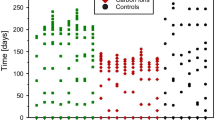Abstract
Using MRI we assessed the changes in signal, size, and contrast enhancement characteristics of the cervical spinal cord in radiation myelopathy developing after radio-therapy for nasopharyngeal carcinoma. We studied two men and five women, aged 40–77 years. The first MRI study was performed 1–4 months after the initial clinical manifestations of myelopathy, and follow-up MRI 2–22 months after the onset of symptoms. On the first study, all patients showed low signal intensity in a long segment of the cervical spinal cord on T1-weighted images, high signal on T2*-weighted images, and focal contrast enhancement at C1-2. In five patients there was also swelling of the spinal cord. The site of eccentric focal contrast enhancement correlated with the clinical manifestations. Follow-up imaging less than 10 months after the onset of symptoms showed no significant changes in signal intensity. Focal contrast enhancement at C1–2 remained the same in three patients, was more dense and larger in one, and less dense in another. Subsidence of swelling was seen in two patients. Atrophy of the spinal cord at C1–2, without abnormal signal and with faint contrast enhancement at C1–2 was revealed as early as 10 months after the onset of symptoms, but the contrast enhancement disappeared by 22 months. There was no correlation between clinical manifestations and spinal cord atrophy on MRI.
Similar content being viewed by others
References
Hung TP (1968) Myelopathy following radiotherapy of nasopharyngeal carcinoma. Proc. Aust Assoc Neurol 5:421–428
Reagan TJ, Thomas JE, Colby MY (1968) Chronic progressive radiation myelopathy, its clinical aspects and differential diagnosis. JAMA 202:128–132
Jellinger K, Sturm KW (1971) Delayed radiation myelopathy in man: report of twelve necropsy cases. J Neurol Sci 14: 389–408
Palmer JJ (1972) Radiation myelopathy. Brain 95:109–122
Wang PY, Shen WC (1991) Magnetic resonance imaging in two patients with radiation myelopathy. J Formosan Med Assoc 90:583–585
Wang PY, Shen WC, Jan JS (1992) MR imaging in radiation myelopathy. AJNR 13:1049–1055
Michikawa M, Wada Y, Sano M et al (1991) Radiation myelopathy: significance of gadolinium-DTPA enhancement in diagnosis. Neuroradiology 33: 286–289
Toffol B de, Cotty P, Calais G et al (1989) Chronic cervical radiation myelopathy diagnosed by MRI. J Neuroradiol 16:251–253
Yasui T, Yagura H, Komiyama M et al (1992) Significance of gadolinium-enhanced magnetic resonance imaging in differentiating spinal cord radiation myelopathy from tumor. J Neurosurg 77:628–631
Author information
Authors and Affiliations
Rights and permissions
About this article
Cite this article
Wang, P.Y., Shen, W.C. & Jan, J.S. Serial MRI changes in radiation myelopathy. Neuroradiology 37, 374–377 (1995). https://doi.org/10.1007/BF00588016
Received:
Accepted:
Issue Date:
DOI: https://doi.org/10.1007/BF00588016




